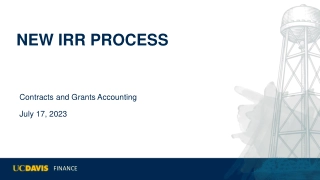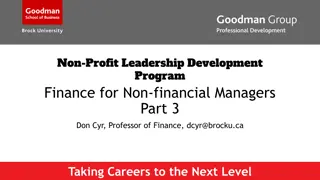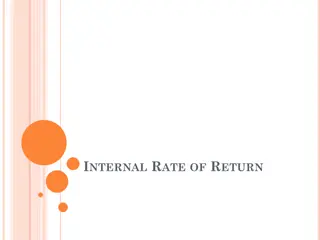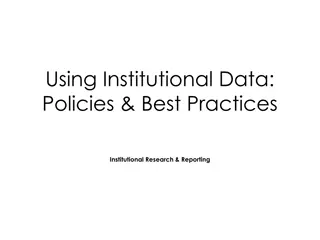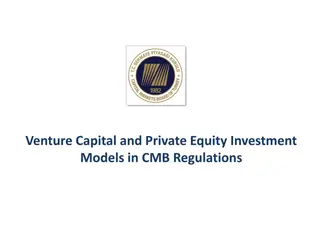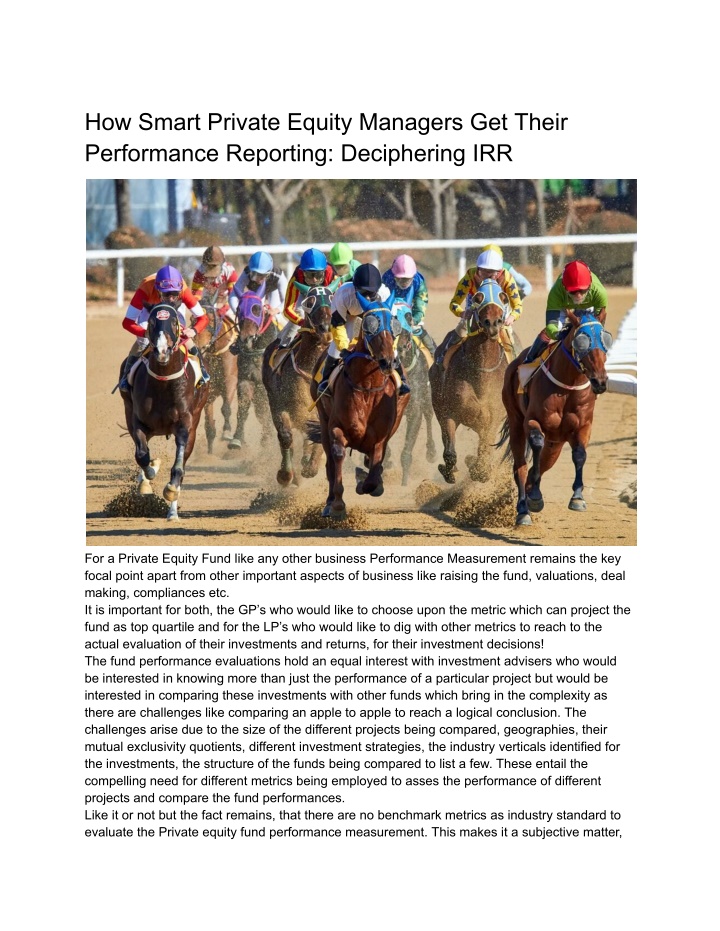
How Smart Private Equity Managers Get Their Performance Reporting_ Deciphering IRR
Understanding and accurately reporting performance is crucial for private equity managers. This guide delves into the intricacies of Internal Rate of Return (IRR), offering insights on how savvy managers interpret and leverage this key metric. Learn the best practices for calculating and presenting IRR to stakeholders, ensuring transparent and effective performance reporting that drives informed investment decisions and builds investor trust.
Download Presentation

Please find below an Image/Link to download the presentation.
The content on the website is provided AS IS for your information and personal use only. It may not be sold, licensed, or shared on other websites without obtaining consent from the author. If you encounter any issues during the download, it is possible that the publisher has removed the file from their server.
You are allowed to download the files provided on this website for personal or commercial use, subject to the condition that they are used lawfully. All files are the property of their respective owners.
The content on the website is provided AS IS for your information and personal use only. It may not be sold, licensed, or shared on other websites without obtaining consent from the author.
E N D
Presentation Transcript
How Smart Private Equity Managers Get Their Performance Reporting: Deciphering IRR For a Private Equity Fund like any other business Performance Measurement remains the key focal point apart from other important aspects of business like raising the fund, valuations, deal making, compliances etc. It is important for both, the GP s who would like to choose upon the metric which can project the fund as top quartile and for the LP s who would like to dig with other metrics to reach to the actual evaluation of their investments and returns, for their investment decisions! The fund performance evaluations hold an equal interest with investment advisers who would be interested in knowing more than just the performance of a particular project but would be interested in comparing these investments with other funds which bring in the complexity as there are challenges like comparing an apple to apple to reach a logical conclusion. The challenges arise due to the size of the different projects being compared, geographies, their mutual exclusivity quotients, different investment strategies, the industry verticals identified for the investments, the structure of the funds being compared to list a few. These entail the compelling need for different metrics being employed to asses the performance of different projects and compare the fund performances. Like it or not but the fact remains, that there are no benchmark metrics as industry standard to evaluate the Private equity fund performance measurement. This makes it a subjective matter,
and an individuals choice to have his own set of metrics to be employed intelligently with each individual fund to understand the performance. The most common measures in the industry to report the fund performance with the GP s remain IRR which has its own strengths and weaknesses, and may not accurately be able to depict the actual returns of the funds due to the assumptions employed, but so remains the challenges with the other approaches like MIRR, Money Multiples (DPI, RVPI & TVPI which are often reported by the funds), PME or PME+. Though none of the methods described above can in isolation give a complete picture of PE performance, nor is there a single right way to measure it. One of the challenges associated with this is the fact that managers can claim to be top quartile by creatively choosing benchmarks that position themselves favourably. LP needs to fully understand the constituents of any benchmark that a manager is using in order to fully assess the relevance to the manager s strategy, in addition there are potentially significant biases in the available benchmark data. There are also many questions around the detail behind the performance metrics. Like whether cash-on-cash multiples are more meaningful than IRRs, how to gauge impressive performance as a result of unrealised versus realised results, the impact of the J-curve and the gross to net performance spread. While the performance measurement techniques described above are a useful tool for assessing PE fund performance, individual investors need to decide which metrics are most appropriate for each situation. Though the comparison of performance statistics is very important for intelligent investment decisions, it is not the end of the road but extends beyond to detailed analyses such as value creation attribution, capital efficiency including the gross-to-net ratio, consistency over multiple time periods and individual analyses focusing on sectors, geographies, sizes, types and key professionals. Let us take a deeper dive into reporting for evaluating the fund performance and comparison of the funds which go along way into intelligent investment decisions and analysis to ensure success for the fund managers and investors alike. IRR remains the favorite with Private equity industry as one of the top metric to report and to compare the performances of funds and their fund managers, despite the known pitfalls and shortcomings. Let s focus on the challenges which are encountered by the stakeholders of private equity with calculations of IRR of a fund and the individual projects which remain a key performance indicator metric, in conjunction with other important metrics like money multiples and PME & PME+ which are de-facto industry reporting practices when it comes to the Private equity fund performance and evaluations. IRR calculations are simple and based on the mathematical formula and can be easily calculated with the help of computer and spreadsheet, is how generally it is spoken about but, still the reporting possesses the challenge! For the right picture of the fund performance to emerge it is imperative that the calculations of IRR are dealt with utmost care keeping in mind the inherent shortcomings of the metric itself generally arising due to the assumption on which it is based The distributed cash is reinvested back at the same IRR. The cash flow over the period of time taken into account for arriving at the IRR may at times lead to skewed results which may not be intentional or planned most of the times. It also depends on the process,
methodology employed and collected data taken into account to reach the right meaningful IRR values. As IRR is solving the polynomial, at times can have more than one value of IRR satisfying the equation and one can land up with multiple values which are both positive and negative! Also there can be case when the cash flow is negative and yet IRR is positive, these situations arise due to the mathematical formula employed to solve the polynomial on spreadsheet. Consolidation of quarterly IRR to arrive at annual IRR, When computed and aggregated throws different values and are not the same as the time value of money comes into play The quarterly and annual IRR s will not be the same because of dates of the cash flows change. This is where the acumen of the fund manager is to be employed. We have two functions on excel which are employed to reach the solution the IRR function(For cash flows at regular intervals a dream coming true for any fund manager) and XIRR function(which allows for the irregular time interval to be taken into account to make the calculations), nevertheless the perennial anomalies like the one listed below remain unsolved in the Excel and keep posing challenges for the asset managers and keep giving them headaches. The #NUM ERROR The IRR function will give a #NUM! error when it takes more than 20 iterations to find the discount rate (IRR) Also if the IRR function does not find at-least one positive and one negative cash flow, it would again throw #NUM! error Unfortunately there isn t a solution to this problem while solving on excel. Multiple IRR In case the IRR formula encounters multiple IRRs it would return the IRR value which is closer to the guess. If the first cash flow isn t negative, the IRR will have more than one solution, and Excel will only display the first one which it finds. Similarly, each time the cash flow changes from negative to positive, another possible solution for the IRR is created and Excel will only display the first one which it finds. The Function on Excel for calculations of IRR, allows the Expected IRR argument which can be passed and is optional. In cases where it is not specified it assumes it to be 10% by default. Reaching a right value depends on your passed expected rate of return to make the calculations and reach the genuine values. So again the problem s solution lies in the judgemental plane then on the fixed rules and the better the guess more accurate are the results! Cash Flow intervals One has to be vigilant and keep a check while working on excel as to what are the cash flows like, that is to say if they are at equal intervals or if they can be assumed to be happening at equal intervals then and only then your IRR function on excel shall give you the right results. However most of the times the cash flow intervals are not equal and in such cases one should always resort to using XIRR function on the excel. Ahh pain remembering it all the times isn t it? Ones again solving on excel you have no option but follow this. For excel to be able to successfully calculate the IRR it should have minimum one +ve cash flow and one -ve cash flow, with a negative cash flow in the starting or at the zeroth instance on the timeline of the cash flow.
False Solution Even if net cash flows are negative, Excel can produce a positive IRR. If cashflows don t occur in the correct order, i.e. negative followed by positive, then the IRR produced can be false. For example, if cash flows at the beginning of a project are small and positive, and at the end of the project are large and negative, the IRR will necessarily need to be high to reduce the net present value of the later cash flows. Operational Difficulties in Handling with Excel Gathering Updated Comprehensive Cash Flows Every time a latest IRR has to be calculated most Excel sheets require updation of cash flows, a tedious, error prone, time consuming process. This requires constant reconciliation to source of data. Adding a new Asset, missing cash cash flows from Asset, updating cash flows that changed during course of business, are some of the critical tasks that can give jitters to even a highly skilled Excel specialist. Size Does Matter For Funds that have investment sizes of over 20 Assets and more than a year s worth of cash flows, this task of organizing and maintaining a spreadsheet becomes a full time effort of a prized resource. It is further compounded by the fact that cash flows for many instruments including fixed income assets or credit assets happen at the end of a month or quarter which is also the time the IRR s need to be published. The timeframes for getting the results are compressed. This leads to accuracy issues and missed cash flows. Slice and Dice IRR Returns on Excel? You must be Kidding This is the dream of any Portfolio Manager, virtually impossible to bring to reality with Excel! Most IRR spreadsheets calculate IRR s at Asset and a few pre-designed aggregated levels like a strategy or an industry. Any changes to this spreadsheet can spell doom with weeks activity to sometimes a month long saga. Assets crossing multiple Portfolios The assets crossing multiple portfolios could result from myriad of reasons including reorganization of a fund, portfolio allocation, new strategies, merging assets from a warehouse facility etc. Each of these situation pose challenges combining and putting together the cash flows. The resulting IRR s can further be complicated by requirement of performance allocations. Such situations require dedicated efforts and can be done seldomly on Excel. Deals with many complex assets It is a herculean task for an analyst to know all the cash flows and the deals in granular details comprising of multiple assets. These assets undergo complex reorganizations like mergers or splits which leads to further complexities and is a nightmare for even an expert on Excel to run up IRR s on such deals! What can be a possible solutions to the problems or the workarounds, for a few listed above there are hardly any solutions with excel and the workarounds for the others may not be viable solutions when the size of the fund grows. There are a few solutions available in the market, which have been specifically targeted at IRR reporting, but none of the solutions have a more comprehensive approach than Pepper which has the most robust IRR engine.
Pepper Solutions Pepper s IRR engine is a robust technology platform that keeps the golden source of all the historical and current cash flows creating a near perfect, no hassle calculation engine that can allow a user to slice and dice a portfolio and still create an accurate IRR. Here are five complex scenarios where the Pepper IRR engine helps in Performance reporting: 1. Gathering Updated Comprehensive Cash Flows Most Excel sheets need to update cash flows when the latest IRR s has to be calculated. This is a tedious, time consuming process and invariably has multiple errors. It further requires constant reconciliation to source of data. Gathering the details of every single cash flow and organizing it on any spreadsheet is a chore not relished by any middle office manager. Adding a new Asset, missing cash cash flows from Asset, updating cash flows that changed during course of business, are some of the critical tasks that require extreme efforts even for a highly skilled Excel specialist. Pepper s IRR engine can traverse the history of every investment, and gather all the applicable cash flows in an automated rules based way, that totally eliminates the tedious chore of gathering the cash flows. 2. Size Does Matter! Nay, not with Pepper- For Funds that have investment sizes of over 20 Assets and more than a year s worth of cash flows, this task of organizing and maintaining a spreadsheet becomes a full time effort of a prized resource. It is further compounded by the fact that cash flows for many instruments including fixed income assets or credit assets happen at the end of a month or quarter which is also the time the IRR s need to be published. The timeframes for getting the results are compressed. This leads to accuracy issues and missed cash flows. Pepper s IRR engine can take a portfolio of any size and create IRR s instantly using its cloud based compute engines 3. Slice and Dice IRR Returns It s child s play on Pepper- This is the dream of any Portfolio Manager, which till Pepper came along, was not even possible. Most IRR spreadsheets calculate IRR s at Asset and a few pre-designed aggregated levels like a strategy or an industry. Any changes to this spreadsheet is a week sometimes a month long investment. Consider the scenario an Asset Manager needs to add a new strategy to his portfolio, retag all assets that are affected and create IRR for each of the new strategy. It s a weeks worth of effort just to add this strategy to a spreadsheet. Pepper relishes these opportunities giving Asset Managers the flexibility to play with the portfolios and slice and dice it with any level of aggregation. 4. Assets crossing multiple Portfolios! Let them There are complex cases in a Portfolio when assets would be crossing multiple portfolio. This could be due to a myriad of reasons including reorganization of a fund, portfolio allocation, new strategies, merging assets from a warehouse facility etc. Each of these situations create challenges in combining and putting together cash flows. There may be requirements for performance allocations which may complicate the resulting IRRs. Most of these situations require dedicated effort and can be done only a few times. This is another situation where Pepper s engine crushes the challenge and can be used to address every such situation. 5. Deals with many complex assets, But that s what Pepper is there for Portfolio Managers think in deals and these deals can have a number of assets. That private assets have complex valuation structures and cash flows is given. But what also happens is these assets undergo highly complex reorganizations including mergers or
splits, morphing them further. All of these activities create complex challenges for putting together cash flows and returns. Not only must the analyst know all about the cash flows he needs to know about the deal in very granular detail. Pepper manages these situations smoothly and can run up IRRs for the Deal with no intervention. These are just a few of many challenges which Pepper handles. To learn more, book your live demo now or write us at info@onpepper.com.


